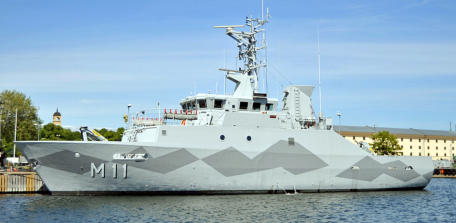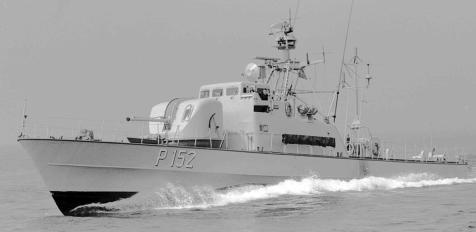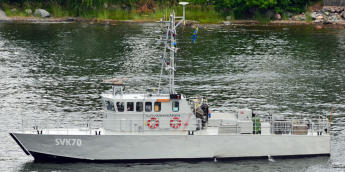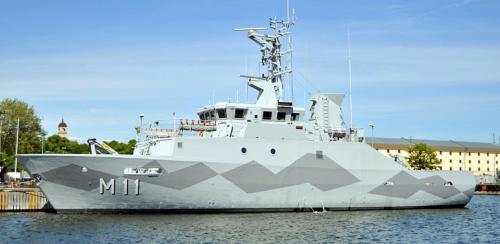

Copyright © Hans Högman 2023-10-02
Ships of the Swedish Navy - 7
Swedish Warships - Surface
Combatants - 6
List of various types of Swedish Motorized
Surface Combatants
•
Battleship
•
Coastal defense ship
•
Cruiser, part-1, part-2
•
Destroyer, part-1, part-2, part-3
•
Frigate
•
Corvette
•
Motor torpedo boat
•
Torpedo boat / Missile boat
•
Patrol boat
•
Picket boat
•
Surveillance boat
•
Minelayer / Minehunter / Minesweeper
Definitions
In the description of the ships, there are some
concepts and terms that may be worth describing.
•
Pennant No., the recognition number that
Swedish warships normally, in peacetime, have
painted on the side of certain types of ships. For
submarines, it is an abbreviation of the
submarine's name. [Hull No. in the US].
•
Delivered refers to the time when the ship was
formally delivered to the Navy from the shipyard.
•
Launched, refers to the time when the ship was
christened and launched.
•
Decommissioned normally refers to the time
when the ship is permanently removed from the
Navy organization.
•
Displacement, expressed in tons, is given with two
values, standard displacement, and displacement
when the ship is fully equipped. If only one value is
given, it refers to standard displacement. For
submarines, displacement is given in surface
mode and submerged mode.
•
Speed is given in knots and refers to the
contracted speed. For submarines, the speed is
given in surface mode and submerged mode.
•
Dimensions, given in meters for length, beam,
and draft. The length may be given in two
dimensions: the waterline and the maximum
overall length. If only one length is given, the
maximum length is referred to. Beam means the
maximum width.
•
Complement, the crew size. It normally refers to
the peacetime crew size.
•
Submarine diving depths indicate the maximum
permitted diving depth in peacetime.
•
ihp = Indicated horsepower (the theoretical
power of a reciprocating engine if it is completely
frictionless)
The abbreviation "HMS" means “Hans Majestäts Skepp
/ Hennes Majestäts Skepp” and is used in the Swedish
Navy as a prefix before the ship's name, such as HMS
Visby. However, HMS was not used by the Swedish
Navy until after 1950. For older ships, i.e. built before
1950, "HM" (His Majesty's) was used followed by the
ship type and name, e.g. HM Kryssare Tre Kronor.
HSwMS is a sometimes used designation for military
ships from Sweden when traveling outside Sweden's
territorial waters, instead of HMS.
In the UK, the same abbreviation stands for Her
Majesty's Ship or His Majesty's Ship and has been used
in the Royal Navy since the 1660s. The USA uses the
designation USS, United States Ship.
During WW II, from June 23, 1940, Swedish warships
were marked with white transverse lines on their
decks and sides so that they could be clearly
identified as neutral ships and thus avoid accidental
fire from the belligerents.
Patrol boat
Only the patrol boats built during the 1970s and early
1980s for the Swedish Navy are discussed below.
These were designated patrol boats but were actually
small surface attack vessels armed with anti-ship
missiles. The vessels' main tasks were, within the
framework of invasion defense, to combat less
qualified enemy naval forces and to monitor and
prevent violation of Swedish territory.
Experimental vessel Jägaren
The HMS Jägaren P150 was the prototype for the
later series of 16 patrol boats built. She was built in
Norway based on the Norwegian Storm-class patrol
boats.
HMS Jägaren was launched in 1972 and delivered to
the Swedish Navy in November 1972. During 1973 -
1974 extensive tests were carried out with the ship.
She remained in service until April 2016. She thus
survived the entire regular series of 16 boats (Hugin
class) for which she was a prototype. HMS Jägaren
initially had the pennant number P151, but when
deliveries of the Hugin class began, she was given the
designation P150.
•
HMS Jägaren P150 (P151), launched in 1972 and
delivered to the Swedish Navy in 1972.
Decommissioned in 2016.
The vessel was 36.5 m long and the beam was 6.2.
The displacement was 140 tons. Speed: 35 knots.
Complement: 18 men.
The machinery consisted of two MTU MB20V 672 TY
90 diesel engines of 3,500 hp each.
The armament consisted of six Rb 12 anti-ship
missiles (type Pigvin) with IR homing devices or 24
naval mines, a 57 mm dual-purpose gun 7102, two 57
mm illumination shell launchers, naval mines, and
depth charges.
In 1988 she was reclassified as a picket boat (Swe:
vedettbåt) with the designation V150. During the
conversion to a picket boat, the 57 mm dual-purpose
gun on the foredeck was replaced by an older 40 mm
dual-purpose gun m/48 (modernized with electric
drive and fitted with a dome). The two MTU diesel
engines s were replaced by two lower-power Cummin
diesel engines. The maximum speed dropped from 35
to 21 knots.
From August 2016, the ship is owned by the Maritime
History Museum, but is operated and managed by the
non-profit Association of Swedish Patrol Boats (FSvP).
Jägaren is now also part of the Veteran Flotilla, with
the Gålö base on Gålö as its home port.
The image shows the Patrol Boat HMS Jägaren P150
in 1973 (here still with pennant number P151),
launched in 1972, delivered to the Navy in 1972. Here
with naval mine rails in the stern instead of Rb 12 anti-
ship missiles. Length 36.5 m, beam 6.2 m. Photo in
1973. Image: Maritime History Museum, ID: Fo46178.
Hugin-class Patrol Boats
The Swedish Navy's 16 Hugin-class patrol boats
(P151 - P166) were built between 1978 and 1982 in
Norway. The series was preceded by an experimental
ship in 1972, HMS Jägaren (P150).
8 of the Hugin class ships (P159 - P166) were
modified in 1992 to provide improved anti-
submarine warfare capabilities.
After the modification, these vessels were designated
Kaparen-class patrol boats. The last three patrol
boats were decommissioned in 2005. However, HMS
Jägaren was operational until 2016.
The main tasks of the patrol boats were, within the
framework of invasion defense, to combat less
qualified enemy naval forces, landing craft, and
aircraft, monitor and prevent violation of Swedish
territory, perform convoy escort services, lay mines,
and anti-submarine warfare.
The patrol boats were more modern than the torpedo
boats of the time, as its reconnaissance/fire control
radar (ArtE 726) was the first to present targets fully
digitally.
The Hugin-class ships were fitted with refurbished
and rebuilt engines from the then discontinued
Plejad-class torpedo boat series, each with three 20-
cylinder Mercedes-Benz MB 518 diesel engines. In the
Hugin-class ships, two of these engines were installed
in each patrol boat.
Ships in the class:
1.
HMS Hugin P151, launched in 1977 and delivered
to the Navy in 1978. Decommissioned in 2001.
2.
HMS Munin P152, launched in 1977 and delivered
to the Navy in 1978. Decommissioned in 2001.
3.
HMS Magne P153, launched in 1977 and delivered
to the Navy in 1978. Decommissioned in 1995, sold
in 1998.
4.
HMS Mode P154, launched in 1977 and delivered
to the Navy in 1979. Decommissioned in 2001.
5.
HMS Vale P155, launched in 1977 and delivered to
the Navy in 1979. Decommissioned in 1995, sold in
1996.
6.
HMS Vidar P156, launched in 1977 and delivered
to the Navy in 1979. Decommissioned in 2001.
7.
HMS Mjölner P157, launched in 1977 and
delivered to the Navy in 1979. Decommissioned in
1995.
8.
HMS Mysing P158, launched in 1977 and delivered
to the Navy in 1980. Decommissioned in 1995, sold
in 1996.
9.
HMS Kaparen P159, launched in 1977 and
delivered to the Navy in 1980. Decommissioned in
2004.
10.
HMS Väktaren P160, launched in 1977 and
delivered to the Navy in 1980. Decommissioned in
2004.
11.
HMS Snapphanen P161, launched in 1977 and
delivered to the Navy in 1981. Decommissioned in
2004.
12.
HMS Spejaren P162, launched in 1977 and
delivered to the Navy in 1981. Decommissioned in
2005.
13.
HMS Styrbjörn P163, launched in 1977 and
delivered to the Navy in 1981. Decommissioned in
2004.
14.
HMS Starkodder P164, launched in 1977 and
delivered to the Navy in 1981. Decommissioned in
2004.
15.
HMS Tordön P165, launched in 1977 and
delivered to the Navy in 1981. Decommissioned in
2004.
16.
HMS Tirfing P166, launched in 1977 and
delivered to the Navy in 1982. Decommissioned in
2004.
The year of decommissioning varies in different
sources but also length, displacement, and speed of
these ships vary but as I interpreted it they were:
The vessels were 33.6 m long (P151 - P158) and 36.6
m long (P159 - P166 after 1992) and the beam was 6.3
m. The displacement was 150 tons (P151 - P158) and
180 tons (P159 - P166 after 1992). Speed: 36 knots.
Complement: 23 men.
The machinery consisted of two MTU MB20V diesel
engines of 3,500 hp each.
The armament consisted of six Rb 12 anti-ship
missiles (type Pigvin) with IR homing devices or 24
naval mines, one 57 mm dual-purpose guns 7102, two
7.62 mm machine guns m/58, two 57 mm illumination
shell launchers, naval mines, and depth charges. Later
also four Elma LLS-920 anti-submarine mortars. The
ships were equipped with the advanced Arte 726 fire
control system.
For anti-submarine warfare, the patrol boats were
equipped with a hull-mounted hydrophone of the
fiskeastic type. In the 1992 mid-term modification, 8
vessels (P159 - P166) were equipped with a more
advanced anti-submarine warfare capability, including
a more advanced hydrophone (towed hydrophone)
and new hull-mounted sonar. Furthermore, four m/84
anti-submarine launchers (type Elma). In addition,
low-speed machinery was installed. The berthing
facilities on board were also expanded and improved.
These 8 ships were fitted with new machinery with
two 16-cylinder MTU-type diesel engines per ship.
After the modification, these 8 vessels were
designated Kaparen class patrol boats.
HMS Munin was unique in one detail from the other
Hugin-class patrol boats: the ship could be steered by
a joystick.
In October 1980, HMS Mode took part in a night
exercise at high speed in poor visibility through a
fairway in the Gothenburg archipelago. The ship ran
straight up onto a rocky islet virtually peeling off its
keel and was in a sinking condition. However, the ship
was salvaged and taken to the navy shipyard, Nya
Varvet. It then took two years of repairs before she
was back in service in early 1982.
HMS Hugin was handed over in "as is" condition to the
Gothenburg Maritime Center in 2001, where she is
located beside the destroyer HMS Småland (J19).
The image shows the patrol boat HMS Munin P152,
launched in 1977, delivered to the Navy in 1978. Here
with mine railings in the stern instead of Rb 12 anti-
ship missiles. Length 36.6 m, beam 6.3 m. Photo in
1980. Image: Wikipedia.
Picket Boat
A picket boat (Swe: vedettbåt) is a small warship
mainly intended for patrolling. Originally, they were
also intended for minesweeping, but this task was
effectively eliminated when the Swedish Navy was
supplied with specialized minesweepers in the late
1930s.
Mk. I picket boat / Jägaren class:
The very first purpose-built picket boats were the four
Jägaren class vessels delivered in the mid-1930s. The
Jägaren class was a series of 4 picket boats in the
Swedish Navy with the names: HMS Jägaren, HMS
Kaparen, HMS Snapphanen, and HMS Väktaren.
The first two were delivered in 1935 and the others in
1936.
The role of the picket boats was to protect the coastal
fleet's larger ships against naval mines and
submarines. All ships in the series were
decommissioned in 1959.
Ships in the class:
1.
HMS Jägaren 21 / 41, launched in 1932 and
delivered to the Navy in 1935. Decommissioned
in 1959.
2.
HMS Kaparen 22 / 42, launched in 1933 and
delivered to the Navy in 1935. Decommissioned in
1959.
3.
HMS Snapphanen 23 / 43, launched in 1934 and
delivered to the Navy in 1936. Decommissioned in
1959.
4.
HMS Väktaren 24 / 44, launched in 1934 and
delivered to the Navy in 1936. Decommissioned in
1959.
The vessels were 54.0 m long and the beam was 6.0
m. The displacement was 310 tons. Speed: 23 knots.
Complement: 41 men.
The machinery consisted of one de Laval steam
turbine of 3,600 hp and two steam boilers. 1
propeller.
The armament consisted of two 7.5 cm guns M/12,
two 25 mm anti-aircraft automatic guns m/32, one 8
mm anti-aircraft machine gun m/36, two depth charge
launchers, two depth charge dispensers, and depth
chargers. The ships were also equipped with a tug
hydrophone.
The image shows the picket boat HMS Kaparen 22
(later 42), launched in 1933, delivered to the fleet in
1935. Length 54 m, beam 6 m. Image: Marinmuseum,
ID: D 14983:46.
The ships had a high bow, one propeller, and a
shallow draft, which made them difficult to maneuver.
As they were equipped with a tug hydrophone, they
can be said to be Sweden's first true anti-submarine
vessels. With the tug hydrophone, the direction of the
target could be determined. In 1941, a high-frequency
hydrophone was installed under the hull. This made it
possible to read the distance to the target. In the
beginning, the ships had pennant numbers (bow
numbers) 21 - 24, but later they were given numbers
41 - 44.
The image shows the four picket boats of the Jägaren
class, here with bow numbers 41 - 44. Photo in 1943.
Image: Maritime History Museum, ID: Fo196373.
Mk. II picket boat:
During the late 1970s and early 1980s, 8 motor
torpedo boats were converted to picket boats to
increase the ability to monitor Swedish territorial
waters. They were HMS Viken V04 (T41), HMS Skanör
V01 (T42), HMS Smyge V02 (T43), HMS Arild V03 (T44),
HMS Öregrund V05 (T47), HMS Slite V06 (T48), HMS
Marstrand V07 (T50), and HMS Lysekil V08 (T51). The
first four were rebuilt in 1976-1977 while the last four
were rebuilt in 1982-1983.
Dalarö class picket boat:
When the picket boats above were to be replaced by
more modern picket boats in the mid-1980s, three
Dalarö class picket boats were built, HMS Dalarö
V09, HMS Sandhamn V10, and HMS Östhammar
V11. The first two were delivered in 1984 and the last
in 1985. The vessels were based on the design used
for the Coast Guard's 280 class.
The vessels were 23.4 m long and the beam was 5 m.
The displacement was 50 tons. Speed: 30 knots.
Complement: 7 men.
They have mainly been used for surveillance, incident,
and sea search & rescue tasks in Öresund (the sound
between Sweden and Denmark).
The image shows the picket boat HMS Östhammar
V11, launched in 1985, delivered to the Navy in 1985.
Length 23.4 m, beam 5 m. Photo: Malmö harbor,
2003. Image: Wikipedia.
The armament was initially a 40 mm automatic
cannon m/48, later a 12.7 mm heavy machine gun.
HMS Östhammar was later based at KA 3 (Coast
Artillery), Fårösund, on the Island of Gotland. During
the first half of the 1990s, the ships were transferred
to the Malmö Naval Station (Swe: Sjöbevakningen i
Malmö) as a replacement for the older Mk. II picket
boats (the converted motor torpedo boats). The
vessels were decommissioned in 2004.
The HMS Dalarö and HMS Östhammar were donated
to the Swedish Auxiliary Naval Corps (Swe:
Sjövärnskåren). The Dalarö class picket boats were
replaced by the Tapper class surveillance boats.
The patrol boat HMS Jägaren P150, which was
delivered to the Navy in 1972, was reclassified in 1988
as a picket boat with the designation V150. The HMS
Jägaren was the prototype vessel for the Hugin class
patrol boats.
Surveillance boat
A surveillance boat (Swe: bevakningsbåt) is a type of
vessel used for various types of naval surveillance
missions, including small, mobile and heavily armed
anti-submarine warfare units.
Mk. 60 and 70 surveillance boat
Mk. 60 surveillance boat, later named Mk. 70
surveillance boat, is a ship class consisting of 17
surveillance boats. The ships are: HMS Torskär (61),
HMS Väderskär (62), HMS Ekeskär (63), HMS Skifteskär
(64), HMS Gråskär (65), HMS Örskär (66), HMS Vitaskär
(67), HMS Altarskär (68), HMS Eggskär (69), HMS Hojskär
(70), HMS Getorskär (71), HMS Flaggskär (72), HMS
Häradsskär (73), HMS Bredskär (74), HMS Sprängskär
(75), HMS Hamnskär (76), and HMS Huvudskär (77). The
ships of the class were built between 1959 and 1968,
replacing the Jägaren class picket boat from the
1930s.
The vessels are 21.1 m long and the beam are 4.6 m.
Speed: 20 knots. The armament consisted of a 20
mm automatic cannon on the foredeck and 6 depth
charges.
The Mk. 60 surveillance boat was modified in the
1980s, after which it was named Mk. 70 surveillance
boat. They then remained in service into the 2000s
when they were gradually replaced by The Mk. 80
surveillance boat (Tapper class). Subsequently, the
Mk. 70 surveillance boat was transferred to the
Swedish Auxiliary Naval Corps (Swe: Sjövärnskåren)
where it is used as a training vessel.
The image shows the surveillance boat HMS Hojskär
70, launched in 1961. Length 21.1 m, beam 4.6 m.
Here is the boat in 2013 in the service of the Swedish
Auxiliary Naval Corps as SVK70 Hojskär. Image:
Wikipedia.

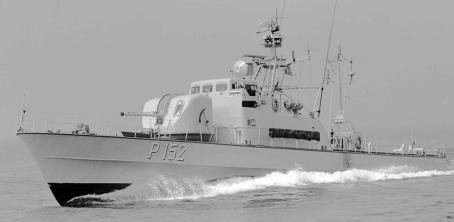


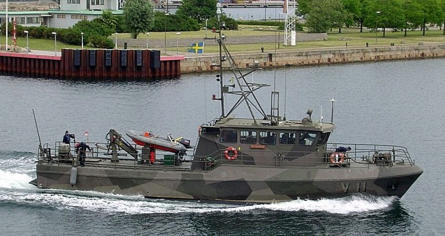

Mk. 80 surveillance boat / Tapper class
Tapper class (Mk. 80 surveillance boat) was a class of
surveillance boats used by the Swedish Navy from
1993. The class consisted of 12 surveillance boats
and was initially stationed at the Coast Artillery
regiments that existed at the time.
The 12 ships of the class:
HMS Tapper 81, HMS Djärv 82, HMS Dristig 83, HMS
Händig 84, HMS Trygg 85, HMS Modig 86, HMS
Hurtig 87, HMS Rapp 88, HMS Stolt 89, HMS Ärlig
90, HMS Munter 91, and HMS Orädd 92. They were
delivered between 1993 and 1999.
HMS Tapper 81 was the first surveillance boat of the
class, delivered to the Navy in 1993. The last ship of
the class, HMS Orädd 92, was delivered in 1999. HMS
Tapper 81 was already decommissioned in 2011.
The vessels were 23.0 m long and the beam was 5.4
m. The displacement was 62 tons. Speed: 25 knots.
Complement: 8 men.
The armament consisted of two 12.7 mm heavy
machine guns. For anti-submarine warfare, six depth
charges, four ELMA mortars for 36 anti-submarine
grenades. Naval mines: four 800 kg mines.
The image shows the surveillance boat HMS Trygg 85,
launched in 1994, delivered to the Navy in 1994.
Length 23 m, beam 5.4 m. Photo: Matti Blume,
Stockholm, 2019. Image: Wikipedia.
After the defense resolution in 2004, 5 vessels were
added to the 17th Surveillance Boat Company in
Gothenburg, a detachment of the Amphibious
Regiment, Amf1 (HMS Rapp 88, HMS Stolt 89, HMS
Ärlig 90, HMS Munter 91, and HMS Orädd 92). These
were transferred to the Älvsborg Amphibious
Regiment, Amf 4, in connection with the
reintroduction of the regiment (Amf4) in 2021. The
other 6 ships were disposed of by the Navy's Maritime
Information Battalion.
In 2013, the Swedish Armed Forces decided to extend
the lifetime of the 5 surveillance boats located at the
17th Surveillance Boat Company at Amf 4.
In 2014, the surveillance boats HMS Dristig 83 and
HMS Modig 86 were taken out of service. Already in
2016, HMS Dristig and HMS Modig were returned to
active service.
In March 2015, the Swedish government announced
plans to reintroduce the Tapper class surveillance
boat. This follows new investments in anti-submarine
warfare capability. In 2015, the rebuilding of the 5
surveillance boats (88 - 92) belonging to the Älvsborg
Amphibious Regiment, Amf 4, began. The HMS Rapp
was the first ship submitted, followed in turn by HMS
Stolt, HMS Orädd, HMS Munter, and HMS Ärlig.
Virtually all systems on board were replaced by new
and modern technology. The ships have sonar to be
able to search for and locate underwater targets. In
the fall of 2020, the last converted ship was delivered
back to the Navy. These boats were then named Mk.
88 Surveillance Boat, Rapp Class (named after HMS
Rapp 88).
In 2015, it was also decided to rebuild the other 6
surveillance boats (82 - 87) in the Tapper class into
reconnaissance boats for inshore anti-submarine
warfare.
These then form a new ship class, reconnaissance
boat, Mk. 82 reconnaissance boat, Djärv class
(named after HMS Djärv 82).
Minelayer
A minelayer is a warship designed to deploy mines.
They can carry a large number of mines and are
equipped with guns to combat attacking aircraft and
missiles.
Every minelayer in Sweden also has a secondary role.
For example, HMS Älvsnabben and HMS Carlskrona
were also training ships for cadets. HMS Älvsborg was
a depot ship for submarines and HMS Visborg was a
command ship for the coastal fleet.
In addition to this, these regular minelayers also had
the task of training crews for the auxiliary minelayers
that would be mobilized during wars. These are
merchant ships that are converted into warships upon
mobilization by equipping them with mine rails and
guns.
Swedish minelayers:
1.
HMS Älvsnabben M01, launched in 1943 and
delivered to the Navy in 1943. Decommissioned
in 1982.
2.
HMS Älvsborg M02, launched in 1969 and
delivered to the Navy in 1971. Decommissioned in
1995.
3.
HMS Visborg M03, launched in 1974 and delivered
to the Navy in 1976. Decommissioned in 2010.
4.
HMS Carlskrona M04, launched in 1980 and
delivered to the Navy in 1982. In service (2023).
HMS Älvsnabben M01
HMS Älvsnabben was designed as a freighter but was
sold to the Swedish Navy during construction on the
initiative of the then Minister of Defense Per Edvin
Sköld. It was then rebuilt as a minelayer and launched
in January 1943 and delivered to the Navy the same
year. She was decommissioned in 1982.
The ship is named after the former naval anchorage
of Älvsnabben in the southern Stockholm archipelago.
In the early years, HMS Älvsnabben was used as a
minelayer. From the beginning of the 1950s, she was
also used as a training ship and carried out 25 foreign
exercise expeditions as a navy cadetship. In 1953 she
made her first long voyage. When then Crown Prince
Carl Gustaf completed his military training, he
accompanied HMS Älvsnabben on a round-the-world
voyage in 1966-1967.
The image shows the minelayer HMS Älvsnabben
M01, launched in 1943, delivered to the navy in 1943.
Length 102 m, beam 13.6 m. Image: Maritime History
Museum, ID: Fo70296A.
•
HMS Älvsnabben M01, launched in 1943 and
delivered to the Navy in 1943. Decommissioned
in 1982.
The vessel was 102.0 m long and 13.6 m wide. The
displacement was 4,207 tons. Speed: 14 knots.
Complement: 265 men.
The machinery consisted of a 9-cylinder Burmeister
& Wain diesel, 3.500 hp. 1 propeller.
The armament consisted of four 15.2 cm m/98G
guns, eight gyro-stabilized 40 mm anti-aircraft
automatic guns m/36, six 20 mm m/40 anti-aircraft
automatic guns, depth charge launchers, and 380
naval mines.
In the early 1950s, all 20 mm anti-aircraft automatic
guns m/40s were replaced by four 37 mm salute guns.
A few years later, the dual 40 mm anti-aircraft
automatic guns m/36s were also replaced by two
single anti-aircraft automatic guns m/48s. The two
15.2 cm guns in the bow were replaced by two 57 mm
dual-purpose m/50B guns in 1961 together with a
modern fire control center with radar sight. At the
same time, the remaining dual 40 mm anti-aircraft
automatic guns were removed. Instead, a 57 mm
m/55 illumination shell launcher was installed.
HMS Älvsborg M02 and HMS Visborg M03
HMS Älvsborg M02 was launched in November 1969
and its sister ship HMS Visborg M03 in January 1974.
HMS Älvsborg was delivered to the fleet in 1971 and
HMS Viborg in 1976.
HMS Älvsborg belonged to the 1st Submarine Flotilla
and served as a command and team ship for the
division. HMS Visborg, in addition to being a minelayer,
also served as the flagship for the Chief of the Coastal
Fleet and his staff, the flag. The Visborg was refitted
in 1998 into an auxiliary ship for the then 2nd Surface
Combatant Flotilla. Her pennant number (bow
number) was thereafter A265. Älvsborg was
decommissioned in 1995 and Visborg in 2010.
The image shows the minlayer HMS Älvsborg M02,
launched in 1969, delivered to the fleet in 1971.
Length 92.4 m, beam 14.7 m. Photo in 1971. Image:
Maritime History Museum, ID: Fo36546.
1.
HMS Älvsborg M02, launched in 1969 and
delivered to the Navy in 1971. Decommissioned in
1995.
2.
HMS Visborg M03, launched in 1974 and delivered
to the Navy in 1976. Decommissioned in 2010.
The vessels were 92.4 m long and the beam was 14.7
m. The displacement was 2,650 tons. Speed: 16 knots.
Complement: 97 men.
The machinery consisted of two NOHAB-Polar 112
VS-F V12 diesel engines of 4,200 hp (2 x 2,100 hp). 1
propeller.
The armament consisted of three dual-purpose 40
mm m/48 guns, one 57 mm illumination shell
launcher m/55, and 300 naval mines. The ships were
also equipped with a helipad at the stern. They also
had a modern fire control system, Arte 62, a radar
warning system, and an optical anti-aircraft sight.
HMS Älvsborg could, in addition to its own key crew,
accommodate and feed 300 men, HMS Visborg just
over 250 men.
HMS Carlskrona M04
HMS Carlskrona was built as a minelayer but was
also used between 1982 and 2005 as the Navy's long-
travel ship. She was launched in May 1980 and
delivered to the Navy in March 1982. Carlskrona came
to replace HMS Älvsnabben (M01) as a long-travel ship.
In addition to the ship's regular crew, she can
accommodate 72 naval cadets. She carried out her
first overseas expedition in 1982-1983 and has since
completed 20 long voyages. HMS Carlskrona was
designed from the outset to serve as a long-travel
ship and was therefore built with ocean-going
capacity.
•
HMS Carlskrona M04, launced in 1980 and
delivered to the Navy in 1982. In service (2023).
The vessel is 105.7 m long and the beam is 15.2 m.
The displacement is 3,550 tons. Speed: 20 knots.
Complement: 162 men.
The machinery consists of four NOHAB-Polar 112
F212 diesel engines of 7,760 kW. 2 KaMeWa propellers
and bow thrusters.
The armament consists of two 57 mm dual-purpose
guns 7102, two 40 mm dual-purpose guns m/48, four
57 mm illumination shell launchers, and 105 naval
mines.
The ship also has a helicopter platform at the stern.
The image shows minelayer HMS Carlskrona M04,
launched in 1980, delivered to the Navy in 1982.
Length 105.7 m, beam 15.2 m. Photo: Erling Klintefors
in 1980. Image: Marinmuseum, ID: MM.V 01652.
In 2002, the ship underwent a mid-life modification
where, among other things, the 57 mm dual-purpose
guns in the stern were removed to make room for a
larger helicopter pad to enable landing for heavy
helicopters. Furthermore, the ship also received a new
fire control system, IT network, etc.
In 2007, it was decided that the ship would be
converted into a signals intelligence vessel to replace
the now-older signals intelligence vessel HMS Orion
(A201). However, these plans were abandoned and
instead, HMS Carlskrona was refitted into a staff
and command ship with the new designation P04.
Between August 2016 and June 2017, a life extension
of Carlskrona was carried out. The aim was to extend
the life of the ship with retained capabilities until
2025.
Minehunter / Minesweeper
Minehunters (Swe: minröjningsfartyg) are a type of
naval vessel that seeks, detects, and destroys
individual naval mines, i.e. they clear naval mines.
They are capable of searching for and neutralizing sea
mines in various ways. The term minehunter is used
in particular for ships equipped to identify and
neutralize individual mines, as opposed to
minesweepers (Swe: minsvepare), that clear mined
areas as a whole, without prior detection of mines, i.e.
they sweep for mines.
A vessel that combines both of these roles is known
as a mine countermeasures vessel (MCMV).
The traditional way of clearing moored mines is
minesweeping, where the ship tows a system of cables
that can cut the anchor chains of anchored mines.
This is called mechanical minesweeping. Ships designed
exclusively for this type of mine sweeping are called
mineweepers.
For bottom mines, so-called distance sweeping is
used, where the ship tows equipment that emits
sound and/or magnetic fields similar to a ship, thus
trying to trick the mines into detonating. The
minesweeper must of course be non-magnetic and
silent running.
A more modern approach to mine clearance is mine-
hunting, where minehunter vessels use imaging sonar
to detect and classify naval mines. Once a mine is
found, it can be defused, usually by blasting, with
charges placed by remotely operated underwater
vehicles (ROV) or clearance divers. Navy clearance
divers are trained divers whose duties include
searching for, documenting, recovering, or destroying
mines.
To prevent the minehunters themselves from
affecting mines, they are usually built in a non-
magnetic material and have a very low acoustic and
pressure signature.
Landsort Class Minehunter
The Landsort class is named after the first ship of
the class in a series of 7 mine countermeasures
ships built between 1983 and 1992. The ships are
named after famous Swedish lighthouses. The ships
also have other capabilities such as anti-submarine
warfare, minesweeping, and minelaying. The Landsort
class ships are: HMS Landsort (M71), HMS Arholma
(M72), HMS Koster (M73), HMS Kullen (M74), HMS
Vinga (M75), HMS Ven (M76), and HMS Ulvön (M77).
The ships are built in glass fiber-reinforced plastic
using the sandwich method.
Ships in the class:
1.
HMS Landsort (M71), lauched in 1982 and
delivered to the Navy in 1984. Decommissioned
in 2009.
2.
HMS Arholma (M72), lauched in 1984 and
delivered to the Navy in 1984. Decommissioned in
2010.
3.
HMS Koster (M73), lauched in 1986 and delivered
to the Navy in 1986. In service (2023).
4.
HMS Kullen (M74), lauched in 1986 and delivered
to the Navy in 1986. In service (2023).
5.
HMS Vinga (M75), lauched in 1987 and delivered
to the Navy in 1987. In service (2023).
6.
HMS Ven (M76), lauched in 1988 and delivered to
the Navy in 1988. In service (2023).
7.
HMS Ulvön (M77), lauched in 1992 and delivered
to the Navy in 1992. In service (2023).
The vessels are 47.5 m long and the beam is 9.6 m.
The displacement is 360 tons. Speed: 15 knots.
Complement: 30 men.
The machinery consists of four V8 diesel engines of
1,072 kW. 2 propellers. The four diesel engines are
coupled in pairs to Voith-Schneider propeller units
with vertical propellers for quiet operation.
The armament consists of one 40 mm dual-purpose
gun m/48, two 7.62 mm machine guns m/58, two
mine-hunting missile launchers, four anti-submarine
mortars m/84 (type Elma), depth charges, and naval
mines.
The system also includes remotely operated
unmanned underwater vehicles (ROV) of the Ulven
and Dubbelulven types and clearance divers.
The image shows the mine countermeasures vessel
HMS Kullen M74, launched in 1986, delivered to the
Navy in 1986. Length 47.5 m, beam 9.6 m. Photo in
2015. Image: Wikipedia.
Koster class:
The ships were midlife modified in the years 2006-
2009 with HMS Koster as the first ship. After this
modification, the ships are referred to as the Koster
class. Then followed Vinga, Kullen, Ven, and Ulvön.
Landsort and Arholma were not modified.
The Koster class ships are equipped with 40-
millimeter automatic cannons with radar-assisted fire
control, which gives them an advanced air defense.
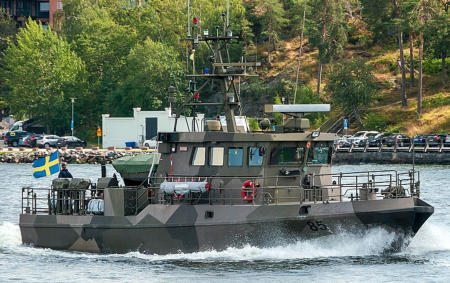



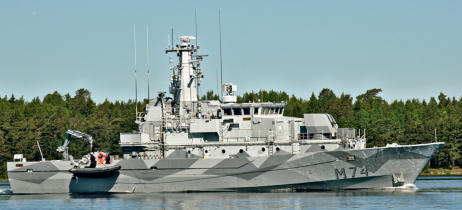
Styrsö Class Minehunter
The Styrsö class is named after the first vessel of the
class in a series of 4 mine countermeasures vessels
built between 1996 and 1997. The vessels are tasked
with minesweeping, minehunting and surveillance.
They are equipped for acoustic, magnetic and
mechanical minesweeping.
Like the Landsort class, the vessels are built in
fiberglass-reinforced plastic but are smaller. The Styrsö
class has traditional propellers and is equipped with
silent thrusters. They were originally built as
minesweepers but are equipped for minehunting.
Ships in the class:
1.
HMS Styrsö (M11), launched in 1996 and
delivered to the Navy in 1996. Decommissioned.
2.
HMS Spårö (M12), launched in 1996 and delivered
to the Navy in 1997. In service (2023).
3.
HMS Skaftö (M13), launched in 1997 and delivered
to the Navy in 1997. In service (2023).
4.
HMS Sturkö (M14), launched in 1997 and delivered
to the Navy in 1997. In service (2023).
The vessels are 36 m long and the beam is 8 m. The
displacement is 250 tons. Speed: 14 knots.
Complement: 16 men.
The machinery consists of two 660 kW diesel engines.
2 propellers.
The armament consists of two 7.62 mm machine
guns m/58, one mine-hunting missile launcher, and
naval mines. The system also includes remotely
operated unmanned underwater vehicles (ROVs) of
the type Ulven and prepared to be equipped with a
clearance diving function.
The image shows the mine countermeasures vessel
HMS Styrsö M11, launched in 1996, delivered to the
fleet in 1996. Length 36 m, beam 8 m. Photo in 2011.
Image: Wikipedia.
HMS Spårö (M12) and HMS Sturkö (M14) were modified
between 2004 and 2005. The possibility of deploying
a minesweep was removed and instead the vessels
were equipped with various clearance diving
installations. The conversion provided space in the
stern for four clearance divers and their equipment,
as well as a pressurized chamber. The ability to search
and identify mines using sonar and remotely operated
underwater vehicles (ROV) has been retained.
These two ships are thereafter referred to as Spårö
class clearance diving vessels.
HMS Skaftö (M13) has been converted into a command
and support vessel for the 17th Amphibious
Surveillance Boat Company in Gothenburg. The ship
has been fitted with a command system, a rebuilt
bridge, an ROV (Remotely Operated Underwater Vehicle)
and new engines.
